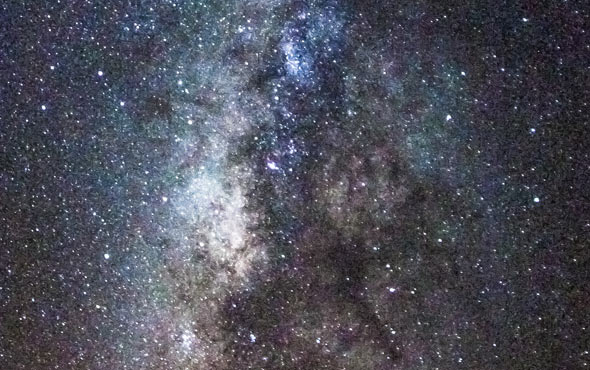Create a free profile to get unlimited access to exclusive videos, sweepstakes, and more!
Hapuna Galaxy

I was recently in Hawaii for Science Getaways, taking a bunch of like-minded science enthusiasts (OK, fine: nerds) to tour volcanoes, beaches, a coffee plantation, a seahorse farm, and lots more. It was fantastic.
My wife and I arrived a couple of days early to set up and also to meet with some friends who were there for HawaiiCon. I’m glad we did—we went out to dinner with Aaron Douglas (yeah, from Battlestar Galactica; he’s not only a good guy, but a major science geek, too) who introduced us to his friend Mary McGlynn.
Mary’s a voice actor (if you’ve watched any anime ever, you’ve heard her voice, most likely) and yet another in a long line of cool people who love astronomy. She had a new camera she was just starting to try out for sky shots and showed me some nice photos she had taken holding it up to a small telescope.
While she was there, she and Aaron took an informal astrophotography lesson from local Hawaii photographer Warren Fintz, who takes some pretty astonishing photos. Apparently, he’s not bad at tutoring, because a few days later Mary sent me this:
Oh wow. She took this on Hapuna Beach, on the west side of the Big Island (where the con was, and not far from where we were doing Science Getaways). Mind you, she had never done anything like this before, but produced a beautiful shot showing our home galaxy. You can see thousands of separate stars, the fuzzy glow of millions more too faint and distant to be seen individually, gas clouds, clusters, and huge streams of dust in space that block the light from the stars behind. You can also see the galaxy is flat (we’re inside it, seeing it edge-on) and has a bulge in the center.
All that, from a short photography session in a spot that wasn’t particularly dark. Amazing.
I post a lot of images from billion dollar space telescopes, professional observatories, and “amateurs” who have tons of experience looking at the night sky. But digital cameras have made it far easier to get great results with only a little bit of experience, too.
And I am not poohpoohing that in any way! Quite the opposite. Getting a nice shot early on is incredibly encouraging, a powerful incentive to keep going. I remember fumbling around with my camera as a teenager, rolling my own film, clumsily attaching it to my telescope, developing and printing the shots myself, only to find I had over- or underexposed the Moon. I kept at it, but then, I was a massive dork. I was already full of incentive.
I envy people starting out today. Astrophotography is incredibly enriching, and so much fun.
And it does something else that’s important: It gets people out under the stars. Even if you don’t have or can’t get a camera, but the sky is accessible to you, take the time to do that. Go outside and look up.
And if you can’t do that, grab a book. Find one online. Go to a museum, or a public science festival, or any place where science can be seen, heard, touched, felt. Go experience the Universe for yourself.
P.S. Astrophotographer Thierry Legault has a book out on how to take photos of the night sky, and I’ll have more to talk about coming soon. Stay Tuned.


























